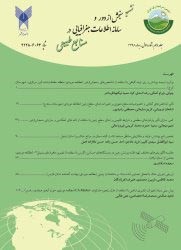ارزیابی شوری خاک با تحلیل تصاویر لندست-8 و مشاهدات زمینی (مطالعه موردی: بهشت گمشده استان فارس)
محورهای موضوعی : توسعه سیستم های مکانیمحمد کاظمی 1 , فریبرز محمدی 2 , علیرضا نفرزادگان 3 *
1 - استادیار مرکز مطالعه و تحقیقات (پژوهشکده) هرمز، دانشگاه هرمزگان
2 - استادیار گروه کشاورزی، مجتمع آموزش عالی میناب، دانشگاه هرمزگان
3 - استادیار گروه مهندسی منابع طبیعی، دانشکده کشاورزی و منابع طبیعی، دانشگاه هرمزگان
کلید واژه:
چکیده مقاله :
شوری خاک ازجمله مخاطرات محیطی بالقوه محسوب می شود. هدف از این تحقیق یافتن بهترین شاخص و مناسب ترین رابطه جهت برآورد شوری خاک و تهیه نقشه آن با استفاده از داده های دورسنجی است. بدین منظور ابتدا نمونه برداری تصادفی با استفاده از روش تور ماهی و اندازه گیری هدایت الکتریکی خاک سطحی (EC) انجام شد. سپس سطوح حد آستانه (92%، 95% و 98%) روی تصاویر خروجی هر شاخص اعمال شد. از روشهای کمترین مربعات رگرسیون شده (LS-fit) و آنالیز مؤلفه اصلی (PCA) برای کانیهای هالیت و ژیپس، همبستگی بین خروجی شاخص ها و داده های زمینی، خوشه بندی و تحلیل عاملی بین مقادیر EC و تصاویر خروجی استفاده شد. جهت انتخاب بهترین مدل حاصل از ترکیب باندهای لندست-8 و میزان شوری، از آزمون هم خطی، آزمون دوربین-واتسون و رگرسیون چندمتغیره پسرو استفاده شد. همچنین جهت ارزیابی رگرسیون چندمتغیره باندهای لندست8، از ضریب کاپای کوهن استفاده شد. کارایی شاخصها براساس چهار معیار مجذور میانگین مربعات خطا (RMSE)، میانگین انحراف خطا (MBE) و میانگین خطای مطلق (MAE) و ضریب تعیین (R2) ارزیابی شد. نتایج تحلیل عاملی کمترین فاصله را بین EC، شاخص شوری (SI) و شاخص درجه روشنایی (BI) نشان داد. به طوری که شاخص SI با مقدار 0.89 بیشترین همبستگی پیرسون را با EC داشت. در نمودار دندروگرام، شاخص SI با EC در یک خوشه قرار گرفتند و مقدار RMSE، MBE، MAE و R2 برای شاخص SI به ترتیب 0.16، 0.11، 0.12 و 0.76برآورد شد. شاخص SI نسبت به بقیه شاخص ها و رگرسیون چند متغیره خطی (با ضریب توافق کاپای کوهن 60%)، نتایج بهتری ارائه کرده است.
Soil salinity is considered as one of the potential environmental hazards. The purpose of this study was to find the best index and the most suitable relationship for estimating soil salinity and its mapping using remote sensing data. At the first step, random sampling was performed using fishnet method and surface soil electrical conductivity (EC) measurements. Then, the threshold levels (92%, 95%, and 98%) were applied to the output images of each indicator. The methodology included using the least squares fitting (LS-fit) technique and principal components analysis (PCA) for halite and gypsum minerals, determining the correlation between the output of indices and ground data, and performing clustering and factor analysis between EC and output images. In order to select the best model derived from Landsat-8 band combinations and the amount of salinity, collinearity test, Durbin-Watson test, and backward multivariate regression were employed. The Cohen‘s kappa coefficient was also applied to evaluate the multivariate regression formed by Landsat-8 bands. The performance of the indicators was evaluated based on four criteria of root mean square error (RMSE), mean bias error (MBE), mean absolute error (MAE) and R-squared (R2). The results of the factor analysis showed the smallest distance between the EC, salinity index (SI) and brightness index (BI). The SI with an amount of 0.89 had the highest Pearson correlation with EC. In the dendrogram diagram, SI index with EC was placed in a cluster, and the RMSE, MBE, MAE and R2 values of the SI index were estimated to be 0.16, 0.11, 0.12, and 0.76, respectively. Compared to the rest of the indicators and linear, multivariate regression (with Cohen‘s kappa coefficient of 60%,), the SI index has provided better outcomes.

